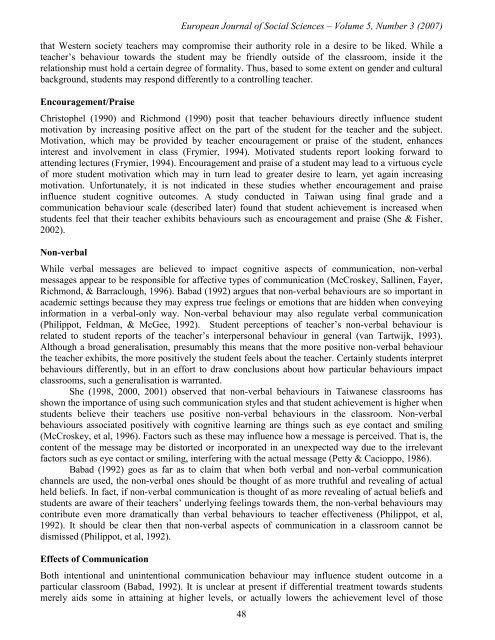european journal of social sciences issn: 1450-2267 - EuroJournals
european journal of social sciences issn: 1450-2267 - EuroJournals
european journal of social sciences issn: 1450-2267 - EuroJournals
You also want an ePaper? Increase the reach of your titles
YUMPU automatically turns print PDFs into web optimized ePapers that Google loves.
European Journal <strong>of</strong> Social Sciences – Volume 5, Number 3 (2007)<br />
that Western society teachers may compromise their authority role in a desire to be liked. While a<br />
teacher’s behaviour towards the student may be friendly outside <strong>of</strong> the classroom, inside it the<br />
relationship must hold a certain degree <strong>of</strong> formality. Thus, based to some extent on gender and cultural<br />
background, students may respond differently to a controlling teacher.<br />
Encouragement/Praise<br />
Christophel (1990) and Richmond (1990) posit that teacher behaviours directly influence student<br />
motivation by increasing positive affect on the part <strong>of</strong> the student for the teacher and the subject.<br />
Motivation, which may be provided by teacher encouragement or praise <strong>of</strong> the student, enhances<br />
interest and involvement in class (Frymier, 1994). Motivated students report looking forward to<br />
attending lectures (Frymier, 1994). Encouragement and praise <strong>of</strong> a student may lead to a virtuous cycle<br />
<strong>of</strong> more student motivation which may in turn lead to greater desire to learn, yet again increasing<br />
motivation. Unfortunately, it is not indicated in these studies whether encouragement and praise<br />
influence student cognitive outcomes. A study conducted in Taiwan using final grade and a<br />
communication behaviour scale (described later) found that student achievement is increased when<br />
students feel that their teacher exhibits behaviours such as encouragement and praise (She & Fisher,<br />
2002).<br />
Non-verbal<br />
While verbal messages are believed to impact cognitive aspects <strong>of</strong> communication, non-verbal<br />
messages appear to be responsible for affective types <strong>of</strong> communication (McCroskey, Sallinen, Fayer,<br />
Richmond, & Barraclough, 1996). Babad (1992) argues that non-verbal behaviours are so important in<br />
academic settings because they may express true feelings or emotions that are hidden when conveying<br />
information in a verbal-only way. Non-verbal behaviour may also regulate verbal communication<br />
(Philippot, Feldman, & McGee, 1992). Student perceptions <strong>of</strong> teacher’s non-verbal behaviour is<br />
related to student reports <strong>of</strong> the teacher’s interpersonal behaviour in general (van Tartwijk, 1993).<br />
Although a broad generalisation, presumably this means that the more positive non-verbal behaviour<br />
the teacher exhibits, the more positively the student feels about the teacher. Certainly students interpret<br />
behaviours differently, but in an effort to draw conclusions about how particular behaviours impact<br />
classrooms, such a generalisation is warranted.<br />
She (1998, 2000, 2001) observed that non-verbal behaviours in Taiwanese classrooms has<br />
shown the importance <strong>of</strong> using such communication styles and that student achievement is higher when<br />
students believe their teachers use positive non-verbal behaviours in the classroom. Non-verbal<br />
behaviours associated positively with cognitive learning are things such as eye contact and smiling<br />
(McCroskey, et al, 1996). Factors such as these may influence how a message is perceived. That is, the<br />
content <strong>of</strong> the message may be distorted or incorporated in an unexpected way due to the irrelevant<br />
factors such as eye contact or smiling, interfering with the actual message (Petty & Cacioppo, 1986).<br />
Babad (1992) goes as far as to claim that when both verbal and non-verbal communication<br />
channels are used, the non-verbal ones should be thought <strong>of</strong> as more truthful and revealing <strong>of</strong> actual<br />
held beliefs. In fact, if non-verbal communication is thought <strong>of</strong> as more revealing <strong>of</strong> actual beliefs and<br />
students are aware <strong>of</strong> their teachers’ underlying feelings towards them, the non-verbal behaviours may<br />
contribute even more dramatically than verbal behaviours to teacher effectiveness (Philippot, et al,<br />
1992). It should be clear then that non-verbal aspects <strong>of</strong> communication in a classroom cannot be<br />
dismissed (Philippot, et al, 1992).<br />
Effects <strong>of</strong> Communication<br />
Both intentional and unintentional communication behaviour may influence student outcome in a<br />
particular classroom (Babad, 1992). It is unclear at present if differential treatment towards students<br />
merely aids some in attaining at higher levels, or actually lowers the achievement level <strong>of</strong> those<br />
48

















